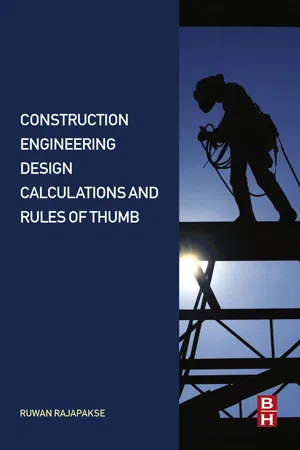
- 474 pages
- English
- ePUB (mobile friendly)
- Available on iOS & Android
Construction Engineering Design Calculations and Rules of Thumb
About this book
Construction Engineering Calculations and Rules of Thumb begins with a brief, but rigorous, introduction to the mathematics behind the equations that is followed by self-contained chapters concerning applications for all aspects of construction engineering. Design examples with step-by-step solutions, along with a generous amount of tables, schematics, and calculations are provided to facilitate more accurate solutions through all phases of a project, from planning, through construction and completion.- Includes easy-to-read and understand tables, schematics, and calculations- Presents examples with step-by-step calculations in both US and SI metric units- Provides users with an illustrated, easy-to-understand approach to equations and calculation methods
Frequently asked questions
- Essential is ideal for learners and professionals who enjoy exploring a wide range of subjects. Access the Essential Library with 800,000+ trusted titles and best-sellers across business, personal growth, and the humanities. Includes unlimited reading time and Standard Read Aloud voice.
- Complete: Perfect for advanced learners and researchers needing full, unrestricted access. Unlock 1.4M+ books across hundreds of subjects, including academic and specialized titles. The Complete Plan also includes advanced features like Premium Read Aloud and Research Assistant.
Please note we cannot support devices running on iOS 13 and Android 7 or earlier. Learn more about using the app.
Information
Construction—General Introduction
Abstract
Keywords
1.1 History of Construction
1.2 Building Construction



Table of contents
- Cover image
- Title page
- Table of Contents
- Copyright
- Chapter 1: Construction—General Introduction
- Chapter 2: Site Work
- Chapter 3: Concrete Construction
- Chapter 4: Steel Construction
- Chapter 5: Construction Equipment
- Chapter 6: Earthwork Construction and Layout
- Chapter 7: Site Layout and Control
- Chapter 8: Highway Curves (Horizontal and Vertical Curves)
- Chapter 9: Trench Excavations
- Chapter 10: Construction Stakes and Markings
- Chapter 11: Earthwork Mass Diagrams
- Chapter 12: Quantity Takeoff and Cost Estimating
- Chapter 13: Equipment Depreciation
- Chapter 14: Engineering Analysis
- Chapter 15: Earned Value Management
- Chapter 16: Construction Operations and Methods
- Chapter 17: Dewatering in Construction
- Chapter 18: Pumps and Pump Curves
- Chapter 19: Scheduling
- Chapter 20: Material Quality Control
- Chapter 21: Temporary Structures
- Chapter 22: Loads During Construction
- Chapter 23: Worker Health, Safety, and Environment
- Chapter 24: Temporary Traffic Control
- Chapter 25: Construction Management
- Chapter 26: Case Studies
- Index